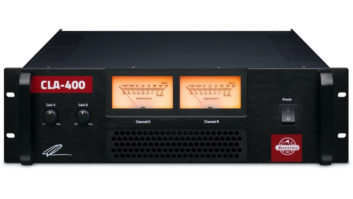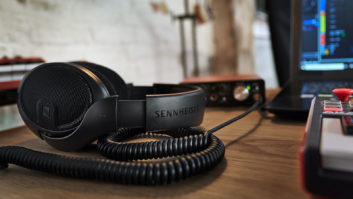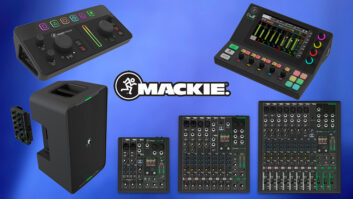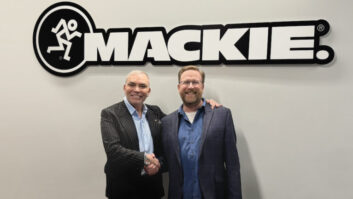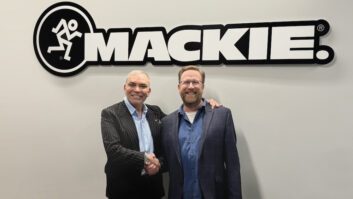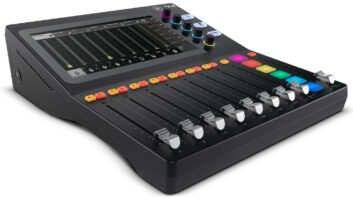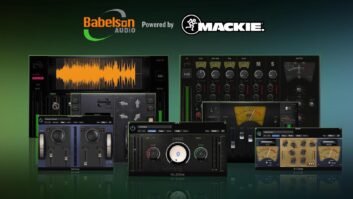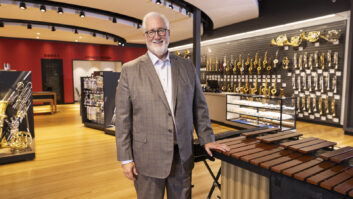Mackie will use this year’s NAB show (booth #5913) to introduce itsnew equipment, including the new FireWire-capable Onyx analog mixersand the dXb*400 professional recording and post-production console.
Following the introduction of the dXb*200 digital production consoleat NAMM earlier this year, Mackie’s dXb*400 (pictured) isdesigned specifically for high-level recording and post-productionapplications. Both the dXb*200 and dXb*400 share the same basicarchitecture and footprint, in addition to the dual touchscreeninterface, 96kHz operation (optional to 192 kHz), o-board automationand effects, 25 high-quality 100mm Penny+Giles faders, configurable I/Ocard cage and a FireWire I/O card option for streaming to/from desktopor laptop computers. Both are compatible with select VST plug-ins andintegrate Mackie Control Universal functionality to control Pro Tools,Logic and other audio software applications.
The dXb*400 features an expansive 96×96 channel I/O matrix (48×48 at192 kHz) and 72 channels of EQ and dynamics at 96 kHz (36 channels withDSP at 192 kHz). The dXb*400 is also equipped with more advancedsurround sound functionality that includes 24 buses, flexible panningassignment and complete surround monitoring features.
An onboard UAD-1 DSP Card comes preloaded into the dXb*400,providing instant access to plug-ins such as Teletronix LA-2A and1176LN compressors, Pultec Program EQ and DreamVerb high-endreverb.
The dXb*400 will be available in late 2004.
Mackie’s new Onyx 1220, 1620 and 1640 analog mixers combines newtechnologies such as extremely low-noise microphone preamps andcircuitry, extended durability, numerous direct instrument inputs intoa modern footprint that includes a FireWire option to integrate intoany computer-based system.
The entire Onyx family derives its name from the inclusion ofMackie’s Onyx mic pre, a low-noise microphone preamp circuitry based onthe XDR mic pre found in Mackie’s compact mixers. They also feature anall-new EQ circuit that was developed for the Onyx line by industryveteran Cal Perkins.
Three small-format mixers make up the Onyx line. The Onyx 1220 is a12-channel (four mic/line inputs and eight line inputs) mixer with twobuses and a 3-band Perkins EQ with sweepable midrange. The Onyx 1620 isa 16-channel (eight mic/line inputs and four stereo line inputs) mixerwith two buses and a 4-band Perkins EQ with dual-sweepable midrange.The Onyx 1640 is a 16-channel (16 mono mic/line inputs) mixer with fourbuses and a 4-band Perkins EQ with dual-sweepable midrange.
Each Onyx mixer also includes an upgrade slot for an optionalFireWire card, which allows the mixers to output a combination ofdirect outputs (from every input channel) and the L-R mix directly intoa FireWire-equipped computer, and, simultaneously, return two channelsof computer audio back to the mixer for monitoring through the phonesmatrix.
Also part of the Onyx family is a new rackmount mic preamp calledthe Onyx 800R. The 8-channel 800R is geared for professional andproject studios seeking a premium mic preamp with 192kHz digitaloutput, as well as any band or sound engineer needing additionalhigh-quality mic inputs for analog or digital mixing consoles. Featuresinclude simultaneous analog and 24-bit/192kHz digital connectivity viaADAT Lightpipe, AES/EBU and S/PDIF to work seamlessly with both analogand digital systems. The front panel provides easy access to featuressuch as selectable mic/line inputs per channel and two instrument inputjacks, replacing the need for an outboard DI box.
Mackie’s Onyx mixers will begin shipping in early Q2 2004. Suggestedretail prices are $639 for the Onyx 1220, $919 for the Onyx 1620 and$1,539 for the Onyx 1640; the optional FireWire card has a SRP of $499.The Onyx 800R will begin shipping later in Q2 2004 and has a suggestedretail price of $1,279.
Also being shown at NAB is Mackie’s Big Knob Studio Command System,a source selection and communications box for DAW-based studios. BigKnob’s name is inspired by its most prominent feature: a large,convenient volume knob that provides easy access for precise leveladjustments. Also featured are three buttons for quick switchingbetween three sets of studio monitors, a built-in talkback microphone,input source select for up to four different stereo sources, dualheadphone outputs with an independent headphone mix bus andmono/mute/dim switches.
Rear panel connections include a dedicated DAW mix input and threeindependent 2-track stereo inputs, each with variable gain control and+4dB and -10dB selection buttons. Three 2-track stereo outputs alsoprovide +4dB and -10dB selection buttons. Other connections include aDAW phones mix input, a phono preamp input, outputs for up to threesets of control room monitors and one set of in-studio monitors, and atalkback foot switch input.
The Mackie Big Knob Studio Command System will begin shipping in Q22004 and has a suggested retail price of $384.
Mackie’s Spike is a complete recording solution that includesthe XD-2 24-bit/96k USB audio/MIDI interface with the company’sdigital preamps and onboard SHARC dynamics processing. Spike is bundledwith Tracktion recording software with VST support, Ableton Live and afree Nomad Factory plug-in.
Tracktion, which is also being distributed independently of theSpike Powered Recording System, is a new audio/MIDI workstation that iseasy to use due to a single-screen interface that provides instantaccess to functions requiring multiple screens. Tracktion is compatiblewith Windows 98/2000/ME/XP and Mac OS X 10.2 and above. The SpikePowered Recording System has a suggested retail price of $495.
For more information, visit Mackie on the Web at www.mackie.com. Formore new product announcements, visit mixonline.com/products_new_products/index.htm.
